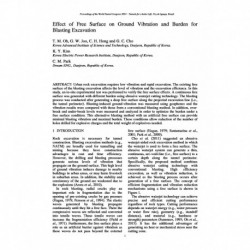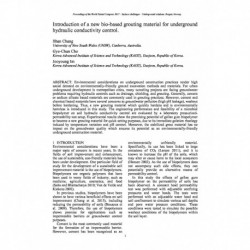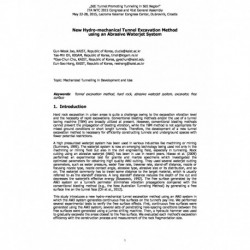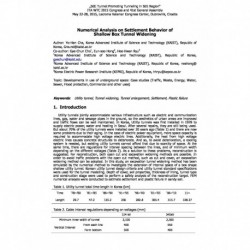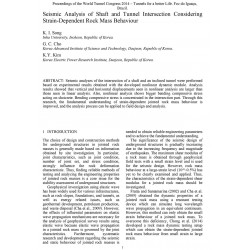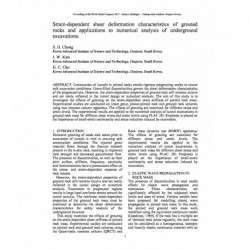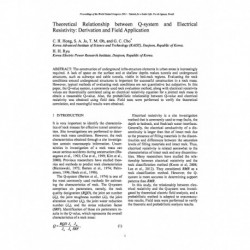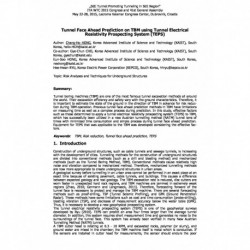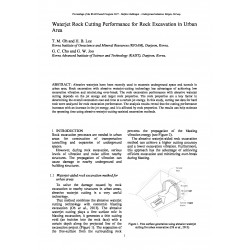No document
Search & filter
Search for a publication
Search & filter
List of products by author: G. C. Cho
-
Effect of Free Surface on Ground Vibration and Burden for Blasting Excavation
Abstract: Urban rock excavation requires low vibration and rapid excavation. The existing free surface of the blasting excavation affects the level of vibration and the excavation efficiency. In this study, an in-situ experimental test was performed to verify the free surface effects. A continuous free surface was generated with different burden using abrasive waterjet cutting technology. The blasting...
0,00 € -
Estimation of Rock Mass Rating (RMR) for TBM using Electrical Resistivity
Abstract: Tunnel excavation using TBMs has many advantages but the TBM method also has some limitations that generate construction delays and increased costs when the TBM runs into problematic sections of ground. Thus, it is important to keep the TBM system safe in the case of unexpected tunnel-ahead ground conditions. To achieve this, the tunnel-ahead prediction system on the TBM needs to reduce the...
0,00 € -
Introduction of a new bio-based grouting material for underground hydraulic conductivity control
Abstract: Environmental considerations on underground construction practices render high social demand on environmentally-friendly ground excavation methods and materials. For urban underground development in metropolitan cities, many tunneling projects are facing groundwater problems requiring hydraulic controls such as drainage, shielding, and grouting. Generally, cement or sodium silicate based...
0,00 € -
New Hydro-mechanical Tunnel Excavation Method using an Abrasive Waterjet System
Abstract: Hard rock excavation in urban areas is quite a challenge owing to the excavation vibration level and the necessity of rapid excavations. Conventional blasting methods and/or the use of a tunnel boring machine (TBM) are broadly utilized at present. However, conventional blasting methods cannot prevent the propagation of blasting vibration, while the TBM method is not appropriate for mixed ground...
0,00 € -
Numerical Analysis on Settlement Behavior of Shallow Box Tunnel Widening
Abstract: Utility tunnels jointly accommodate various infrastructure such as electric and communication lines, gas, water and sewage pipes in the ground, so the aesthetics of urban areas are improved and traffic flows can be well maintained. In Korea, Utility tunnels was first installed in 1978 to supply electric power, water and heating in Seoul. After several repairs, they are still being used. But...
0,00 € -
Seismic Analysis of Shaft and Tunnel Intersection Considering Strain-Dependent Rock Mass Behaviour
Abstract: Seismic analyses of the intersection of a shaft and an inclined tunnel were performed based on experimental results obtained with the developed nonlinear dynamic module. Analysis results showed that vertical and horizontal displacements seen in nonlinear analysis are larger than those seen in linear analysis. Also, nonlinear analysis shows bigger bending compressive stress acting on shotcrete....
0,00 € -
Strain-dependent shear deformation characteristics of grouted rocks and applications to numerical analysis of...
Abstract: Construction of tunnels in jointed rocks entails rigorous pregrouting works to ensure safe excavation conditions. Grout-filled discontinuities govern the shear deformation characteristics of the pregrouted site. However, the strain-dependent properties of grouted rock still remains elusive and are rarely reflected in the tunnel design or numerical analysis. The aim of this study is to...
0,00 € -
Theoretical Relationship between Q-system and Electrical Resistivity: Derivation and Field Application
Abstract: The construction of underground infra-structure elements in urban areas is increasinglyrequired. A lack of space on the surface and at shallow depths makes tunnels and underground structures, such as subways and cable tunnels, viable in bed-rock regions. Evaluating the rock conditions around underground structures is important for successful construction in a rock mass. However, typical methods...
0,00 € -
Tunnel Face Ahead Prediction on TBM using Tunnel Electrical Resistivity Prospecting System (TEPS)
Abstract: Construction of underground structures, such as cable tunnels and sewage tunnels, is increasing with the development of cities. Tunnelling methods for the construction of underground structures are divided into conventional methods (such as a drill and blasting method) and mechanized methods (such as the Tunnel Boring Method, TBM). Conventional methods cause relatively high noise and vibration...
0,00 € -
Waterjet Rock Cutting Performance for Rock Excavation in Urban Area
Abstract: Abrasive waterjets have been recently used to excavate underground space and tunnels in urban area. Rock excavation with abrasive waterjet-cutting technology has advantages of achieving low excavation vibration and minimizing over-break. The rock excavation performance with abrasive waterjet cutting depends on the jet energy and target rock properties. The rock properties are a key factor in...
0,00 €

